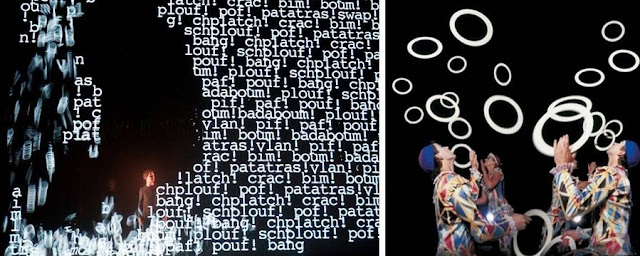Digital pattern dotted on shrieking hue of magenta.
This is a detour from the mainstream review of the show, namely a state-of-the-art scenographic realization of digital art, optical illusions and dance sets. In the cultural-archeological perspective, Cinematique can be read as one subscribing contributor among many in the evolution of nouveau cirque. The work, created by Adrien Mondot in the traditional genre of circus, is exemplary of the collective undertakings of artistic developments in Europe.
Parallels of Quintessential Circus Acts
As in most traditional circus shows that are made up of sequence of unrelated acts, this performance unashamedly did not seek to constrict a particular storyline as a whole. With digital wizardry, illusion acts and choreography, the audience might be easily distracted to think along the line of a contemporary multi-media extravaganza. But stripping away the flaring appearances, it was a straightforward work in the language and expressions one could identify with as in an evening of European circus show.

Cinematique (left): Dance duet in symbolic refuge watching computer graphics break loose.
Vintage circus (right): Ubiquitous pedestals on which performance are found.
Cinematique (left): Mondot and Noro running into virtual landscape.
Vintage circus (right): Crowns running in acrobatic motion.
Cinematique (left): Substituting real fire with battery powered torch under digital skies.
Vintage circus (right): Typical acrobatic play with fire.
Cinematique (left): Illusory wall comes tumbling down.
Vintage circus (right): Pattern making fun.
Cinematique (left): Ten-minute sensational crystal ball juggling.
Vintage circus (right): Jugglers in perfunctory action.
The show in Brief
Stage setting: digital projections from foreground and above.
To recount, the first two acts of cautious step play on moving pebbles and evasive footwork against gushing water re-enacted motions of insecurity like animals trotting on raised platforms or jumping through steel loops. The other acts including rafting on overturned table, running along digital landscapes, interacting with fire (in this case digital shooting stars) and of course, the amazing juggling act in the finale were all recurring themes in the circus genre.
Scenography combining dance set and juggling act.
It is not surprising to learn that Adrien Mondot and Satchie Noro have their core backgrounds in street performances and circus acts. In fact, Cinematique is the winner of the newcomer prize at the 2004 Jeunes Talents Cirque Europe. Through the open and pluralistic cultural backdrop of Europe, be it the players, award systems and audience participation, it is evident that the circus, an age-old performance type, is very much alive and only too keen to transform itself in this continent.
The case in Asia
The case in Asia
Typical circus in Asia where technical skills rule.
So how does the ecology of circus art behave in this part of the world? Is the Asian circus or acrobatic performance able to regenerate itself with digital art or by other contemporary means? Do we have a motivating platform vaguely comparable to the prestigious circus competition of Europe? Leaving aside the archetype of circus and observe in general, we should be gratified to find any traditional performance with a will to break mode, no matter if it is reviewed positively or not. By prescribing this approach, new lease of life may be possible for traditional arts like Kunqu opera, Kabuki theatre and classical Thai dance, to name but a few.
Break the Mode
Dancer Akram Khan in Gnosis, fusing Indian sub-continent dance with contemporary spirits.
Thunderous banging and juggling in the Nanta show from which undertones of Korean national drum performance are obvious.
At this juncture, it is not to say that we shall let go with tradition. With due respect for the purists, the traditional modes of performances are vital. But they should not be the end in themselves; and for those who believe in changes, it is paramount that traditional works can revamp themselves to fit in with the change of times
Passing Gift
In this light, all serious attempts to make room for change or be bold enough to re-invent itself should be given credit. Any new input from one work is valuable. When ideas are plentiful and lent themselves where needed, it acts like a “passing gift” from which creativity is handed from one troupe to another. This is what the cultural critic Lewis Hyde in The Gift (1983) argues regarding true artistic developments being nourished in an open system, and in time shared among individuals or groups through the process of creation. Artistic evolution and growth, like building blocks, requires accumulation of ideas through small contributions of individual entities. This is what we believe in – the living arts.
An epilogue after the Performance
Kungqu opera: The Peach Blossom Fan (1699) 《1699‧桃花扇》, not an artistic breakthrough, but a step in the creative direction.
An epilogue after the Performance
Drifting on virtual waters.
Raining on my way home.
The poetic images of digital illusions and dances have left Sundial with lasting impressions, particularly on the night after the show. As the rain was falling heavily on my way home, for once I negotiated along the puddles of water like Mondot and Noro did without any feeling of irritation.
Cinematique was performed at the Hong Kong City Hall
on 22-23 June, 2011.














No comments:
Post a Comment